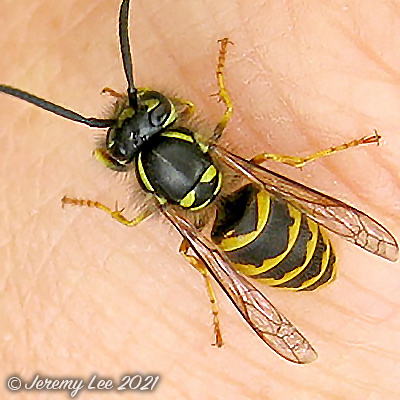
 |
|
Scientific Classifications explained » Amphibians » Ants » Aphids » Bees » Beetles » Birds » Bugs » Butterflies » Caterpillars » Damselflies » Dragonflies » Earwigs » Flies » Frog/Leafhoppers » Fungi » Galls » Grasshoppers » Harvestmen » Hoverflies » Lacewings » Ladybirds » Leaf Mines » Lichens » Mammals » Millipedes » Mosses » Moths » Sawflies » Slugs » Snails » Spiders » Trees » Wasps » Wild Flowers » Woodlice |
UK Nature > Wasps > Vespula vulgaris

Scientific Name: Vespula vulgaris Common Name: Common Wasp Vespula vulgaris, more commonly known as the common wasp, is usually between 15 - 20 mm in length and has bright yellow and black bands along the body, with an obvious 'waist' between the thorax and abdomen. They also have two pairs of wings and fairly long, robust antennae. The sting is located at the tip of the abdomen. The queens (reproductive females) are larger than workers (non-reproductive females). Vespula vulgaris can be distinguished from other similar social wasps by the anchor-shaped mark on its face. It is found in a wide range of habitats and is common in gardens, woodlands and meadows as well as around habitation. The common wasp usually forms large colonies below ground, but occasionally nests may be made in wall cavities, hollow trees and attics. Queens emerge from hibernation during the spring, and they search for a suitable location in which to start a new colony. She then begins to build the nest with chewed up wood pulp, which dries to make a papery substance. A few eggs are laid, which develop into non-reproductive workers. These workers eventually take over the care of the nest, and the queen's life is then devoted solely to egg laying. At the end of autumn a number of eggs develop into new queens and males, which leave the nest and mate. The new queens seek out suitable places in which to hibernate, and the males and the old colony (including the old queen) die. Widespread and common throughout Britain, especially in the south. |
|

https://www.uknature.co.uk is a website dedicated to showing the immense diversity of UK nature and wildlife. Our vast range of habitats, from lowland arable to snow covered mountains, from storm-ravaged coastlines to peaceful inland freshwater lakes and rivers, from dry, sandy heaths to deciduous and coniferous forests, all these habitats contribute to the abundance of UK nature. We have wild birds in huge numbers either residing or visiting our shores (597 recorded species as at July 2013) and we must also not forget the humble back garden with its grass lawns, flower beds filled with nectar rich flowers, shrubs and trees, all designed to attract huge numbers of insects such as bees, moths, butterflies and hoverflies; and finally the small ponds which provide safe havens for frogs, toads, newts and even slow worms and grass snakes. www.uknature.co.uk is the showcase for my personal passion, photographing uknature in all its glory. I sincerely hope you all enjoy the fruits of my labours. This site and all images contained therein is © Jeremy Lee 2004 - 2021. All Rights Reserved. Site design by Jeremy Lee. Site development & IT Support by Stuart Lee. |